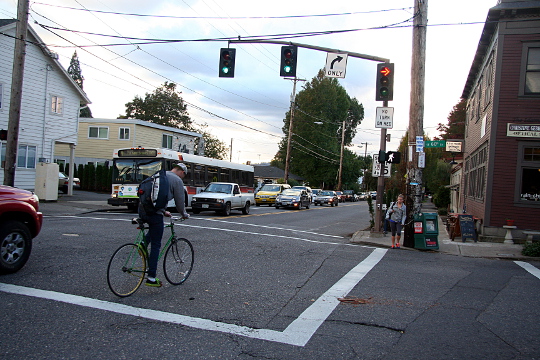
(Photos © M.Andersen/BikePortland)
As inner Southeast Division Street grows up — literally, thanks to its new hedge of multi-story apartment buildings — Portland’s transportation bureau decided in April to redesign a section of the thoroughfare a bit further out to feel more like the city street it now is: with better walking and biking plus a regular flow of slower-moving traffic.
Instead of four narrow travel lanes, Division between 60th and 82nd now have one bike lane and one auto lane in each direction, plus a shared center turn lane.
We wanted to know what local folks thought about the restriped street. So I pedaled down during the Monday evening rush hour, stashed my bike around a corner, and walked around introducing myself as “a reporter” and asking what people thought.
I learned two things: That everyone I met more or less likes it, and that low-car life is now very common in mid-Southeast Portland.

to make her want to raise children in the area.
“I think it’s great,” said Adrienne Ellis, who lives in an apartment building at SE 76th and Division. “They needed to do it a long time ago.”
Ellis, who said she doesn’t own a car, moved to South Tabor a year and a half ago because inner Northeast’s Boise neighborhood had become “douchebag central.”
“Driving traffic is a little worse, but I prefer it because of the bicycle lanes,” said Ellis of the road changes. She said she usually rides the bus because her bike is currently in “disrepair.” “People in Portland refuse to get around without a car.”
As she spoke, she gestured to the line of cars on Division, slowing down for a stoplight a block away but still rolling. “This is as bad as it gets.”
Angel Villalvir, who said he lives in another nearby apartment building, said traffic was “a little crazier” since an auto lane was removed, and cars sometimes back up. But he didn’t mind.
“It’s good for the bike lane,” Villalvir, who was waiting for a #4 bus, said in his thick Spanish-language accent. He shrugged and smiled. “I don’t have a car right now, so it works for me.”
A weathered blond man pedaling westward in the bike lane was proud to endorse the changes. “”It’s the best idea they ever had,” he said. “They did that to another street here, too — Holgate. They say Portland’s the most bike friendly city there is.” Asked if he could pause for a photo, the man said no and quickly pedaled away.
Emily Burke, hoisting her young son out of their car at a house just north of Division, called the changes “a good thing,” making turns easier and reducing obstructions from buses or left-turning cars.
“It’s nice to see bikes on it,” she said. “Even though I’m not a big biker. … I don’t think it’s changed the traffic flow much. It was always essentially a one-lane street.”
Ron Lowery, smoking a cigarette with friends while they looked out on the street, said the traffic seemed to back up more but that “the bike lanes are nice.” He said he, too, got around mostly by bus.
“There’s a lot of foot traffic,” Lowery said. “Not having to back off the curb is nice.”
Though Division is definitely not crowded with bikes this far east, I saw 15 to 20 bikers — various ages, mostly but not entirely male, plus one father and two kids — in the half-hour I spent on Division at 76th. One man was riding in the sidewalk, as many did before the redesign.
In an interview with the Portland Tribune last week, city spokesman Dylan Rivera said the changes will actually reduce average auto travel times, thanks to the new turn lane. What’s definitely different about the new street is that more cars are moving at or below the 35 mph speed limit, something only 44 percent did before. The city also has yet to install traffic detectors at stoplights, something likely to reduce backups.
The Division restriping is one of several the city is pursuing on major streets in the mid-east side. NE Glisan got a similar redesign this summer between 67th and 80th, but with parked cars rather than bike lanes on each side. Foster Road is in the midst of a similar process.
For me, the only slightly uncomfortable part of the road to ride came at NE 60th, where the new design uses green stripes and sharrows to indicate that bikes should proceed straight ahead while cars (which are still moving at fairly high speeds) cross into a right turn lane. This rider, who was preparing for a right turn himself, hugged the curb even though it probably would have been safer to claim the full turn lane:
Then there’s the other side of 60th, the start of Division’s fast-growing commercial and residential district. Here, real estate becomes more expensive, foot traffic more economically important and biking more common … and, ironically, it’s also where the city begins to devote 40 percent of the street to unlimited free storage of private vehicles. Southeast Division still has a lot of city-building left to do.



